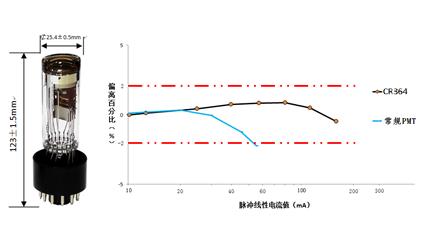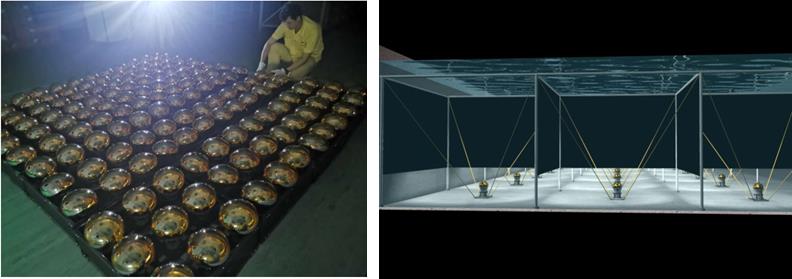000
When detecting high energy physics, the target signal is often extremely weak. In addition to higher performance, the photomultiplier tubes (PMTs) need have larger aperture sizes and face a large number (tens of thousands of pcs) of pulse supply requirements. How can we meet the demand of such a large quantity on the premise of guaranteeing the performance of each product? We have to show our strength. For this, Beijing Hamamatsu has made great efforts.

With the development of high energy physics, the definition of "elementary particle” has changed. Meson is no longer the smallest unit of matter. The research is gradually focused on the particles less than 10-16m. The research method has also developed from cosmic ray observation to the large-scale scientific facilities mainly including particle accelerators and large-scale detectors. Then, let me show you the features of a PMT for high-energy physics.
• Pulse linearity
Because the light detected in high energy physics applications is extremely weak, besides high sensitivity requirements, the PMT is required to have extremely high pulse linearity, so as not to lose the occasional strong signals while detecting very weak signals. Normally, when the PMT output linearity deviates 2%, the pulse linear current is generally 20mA~40mA, while when it is used in the high energy physics, the pulse linear current of the high-linearity PMT can reach more than 100mA at the same deviation.

• Detection area
Neutrino is one of the most elementary particles that make up the material world. It plays an important role in microphysical particle law and macrocosmic evolution, with very small mass and not charged. The sun, cosmic rays and nuclear power plants can produce a large number of neutrinos, which only participate in very weak interactions, have extremely strong penetration and even can penetrate a light-year thick lead plate①. Only one out of 10 billion neutrinos reacts with matter, so it is very difficult to detect neutrinos. Because of this, people know the neutrinos at the latest and at least② among all the elementary particles. Neutrino detectors must be large enough to allow for a sufficient number of neutrinos to be observed for long enough time (a few years).
To effectively filter the interference of other high-energy particles, the detector needs to be set deep underground. When neutrinos near the speed of light enter the giant test pool, very few neutrons can generate Cherenkov radiation in the water, emit weak light between ultraviolet and blue bands and be finally captured by the PMT. Therefore, it is necessary to increase the detection area to improve the detection efficiency under the premise of ensuring the normal performance of the PMT. The size increase must also ensure that the PMT can withstand a water pressure of 0.7Mpa and operate steadily for a long time under this environment.

• Background light influence
• Signals in high energy physical detection are sometimes influenced by background light. Under the condition that background light cannot be completely shielded, measures must be taken to minimize the influence from the detection end, i.e. the output change rate of the PMT in the presence of background light shall be ≤10%. Routine PMT performance generally involves sensitivity, dark current (dark count rate), working temperature, etc. The background light influence is unique to high energy physics application. Beijing Hamamatsu, starting from the characteristics of the PMT, only took less than a year and overcame the background light influence.
• Temperature coefficient
The PMT is more susceptible to ambient temperature than conventional electronic devices (resistors, capacitors, etc.). Therefore, during the high-precision testing, the PMT usually adopts temperature control and comparative photometry to minimize the influence of ambient temperature variation on the PMT. However, in high energy physical applications, the ambient temperature difference under individual extreme conditions is even as high as tens of degrees Celsius, and it is not convenient to control from the periphery. Therefore, Beijing Hamamatsu can provide PMT with a temperature coefficient of less than 0.1%/℃(normal PMT temperature coefficient ≥0.3%/℃). The reduction of temperature coefficient by 0.2 percentage points not only improves the PMT manufacturing capability of Beijing Hamamatsu, but also achieves a qualitative leap in the PMT performance.
Therefore, to produce PMTs for high-energy physics, it is impossible for technicians without dedicated research and long-term accumulation; For enterprises, it is difficult to make it without rich experience and rigorous attitude. In addition, what is valuable is our “heart of sincerity”:
• Integrity in product technology;
• Sincerity in customer demands;
• Dedicated photon cause;
It is due to sincere manufacture that Beijing Hamamatsu has always been brave and unstoppable on the way of exploring the unknown, expecting to make more contribution to the research of high-energy physics in China and even the world.
①: Excerpt from Tencent <<1 light-year thick lead plate is not necessarily able to block neutrinos, why do neutrinos have so strong penetration?>> (https://new.qq.com/rain/a/20220109a09l5d00);
②: Excerpt from <<Neutrino: Mysterious “Invisible Man” on>> http://www.xakpw.com (https://www.xakpw.com/single/21919).